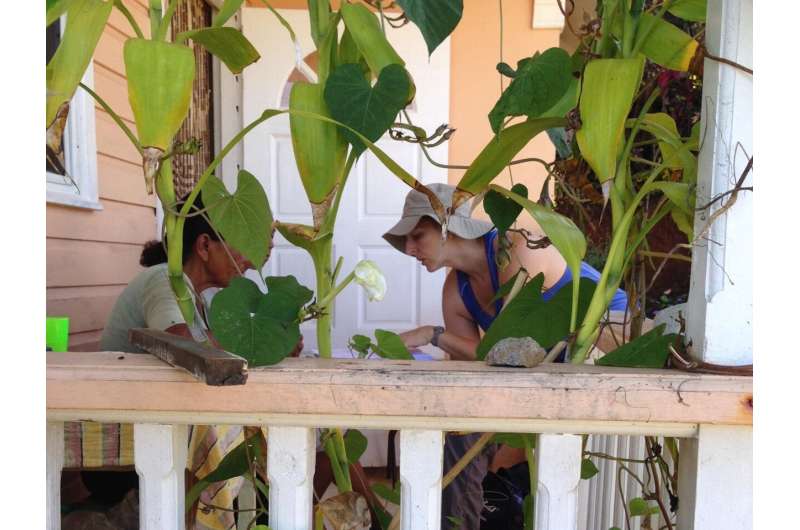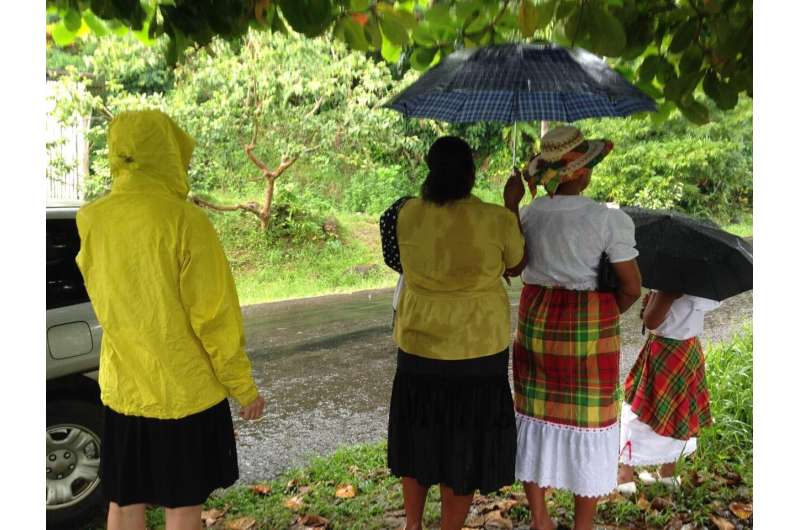This article has been reviewed according to Science X's editorial process and policies. Editors have highlighted the following attributes while ensuring the content's credibility:
fact-checked
peer-reviewed publication
trusted source
proofread
Genetic link between skin tone and ancestral origin complicated by new discovery

A team of Penn State geneticists is pursuing the answers to an age-old question of human biology: the genetic origin of fundamental variations in skin pigmentation between people of different ethnicities. The link between skin pigmentation and ethnicity is more complicated than previously believed, according to new research published in the journal eLife.
The team has confirmed that genes associated with East Asian and Native American ancestry, rather than the genes underpinning lighter skin in people with European ancestry, explain the lighter skin of people of East Asian and Native American descent. Learning which genes are responsible for regulating skin tone, depending on a person's ancestral origin, has broad implications for genetic research, according to the team, especially as it relates to preventing or treating certain skin cancers.
"We're a step closer to laying a foundation for understanding where we came from, how color change occurs molecularly and why skin color change is more associated with sun-induced melanoma in Europeans," said co-corresponding author Keith C. Cheng, distinguished professor of pathology and laboratory medicine, of biochemistry and molecular biology, and of pharmacology at Penn State.
A key clue to understanding the evolution of human skin tones resides in the genome of a small population in the Commonwealth of Dominica, according to Cheng. Situated a two-hour ferry ride north of the popular island of Martinique, the tiny, rocky island of Dominica is home to the Kalinago people, who have the least European ancestry of any Native American population in the Caribbean.
Cheng first connected with the tribe—whose ancestry comprises primarily Native American and African lines—15 years ago, after his lab identified the gene responsible for lighter skin color in Europeans. In 2009, Cheng and co-corresponding author Khai C. Ang began work with the geographically and genetically isolated Kalinago people to rule out the possibility that the same gene also regulates skin tone in Native Americans and East Asians.
"After identifying the variant of the gene SLC24A5, the primary contributor to lighter skin color in Europeans in 2005, the next obvious question was: What about similar skin tones in Native Americans and East Asians?" said Cheng, who led the team that made this discovery.
"Both populations are relatively light skinned, but Europeans are at least 15 times more likely to get melanoma. Why don't East Asians and Native Americans experience skin cancer at the same rate?"
The science of skin color
"Skin color differences have long been a mystery of human biology," said Ang, assistant professor of pathology and laboratory medicine at Penn State.
All humans originated in Africa, and as they expanded their footprint to the rest of the world, two main migration branches emerged: the European branch, which includes peoples on the Indian subcontinent and Europe; and the East Asian branch, which includes East Asia and the Americas. People in both branches adapted to geographically and climatically different areas.
One such adaptation involved melanin, the cellular pigment responsible for darker tones in skin, hair and eyes. It offers some protection from sunlight's ultraviolet (UV) rays, which can damage skin cells. But in the northern latitudes of Europe and Asia, melanin also limits the production of vitamin D, which is critical to human health, Ang said.
"A biological benefit of sunlight is vitamin D, which the body produces from UV exposure," Ang said. "In places with lower UV rays, people with less melanin make better use of whatever exposure they have."
For this reason, both Native Americans and East Asians appear to have less melanin than people with African ancestry, but they are less likely than Europeans to develop melanoma, according to Ang.
"There are multiple modifications in the human genome that can influence skin tones, but humans have historically been classified by ancestry into three major groups: African, Native American/East Asian and European/South Asian," Ang said. "European skin is more sensitive to UV damage despite having similar shades as East Asians and Native Americans. Some cellular and genetic mechanism must protect against such damage."

Now that the team has confirmed that different genes are responsible for skin tones in each migration branch of humanity, Cheng said, researchers can begin to better understand why the European mechanism of lighter skin results in higher rates of melanoma among Europeans.
"This work confirms that separate genetic mechanisms were involved in the evolution of lighter skin in each of the human migration branches," Cheng said.
The Kalinago collaboration
The work was more involved than simply testing genes, though, according to the researchers. The Kalinago people were, Cheng said, "rightfully guarded before generously participating in this work."
"I went into this with a naïve, idealistic perspective—that science could benefit everyone, including this group," Cheng said, noting that he quickly learned that many Kalinago had good reason to be skeptical. "Scientists have worked with populations like this before without benefiting them. The Kalinago people's history of contact with the European world was fraught with colonialism. One can't blame them for being suspicious."
Cheng, Ang and their collaborators spent more than a decade building relationships with the Kalinago people and their leadership. Kalinago councils comprising elected officials oversee the community. New elections every few years meant that the researchers had to earn tribal buy-in with every leadership change.
"We had and continue to have discussions with the Kalinago Council and nurses in the community about the project and how they potentially can help solve of the mysteries of human skin pigmentation, emphasizing their contribution to science," Ang said. "And they agreed to help. That was amazing."
The researchers made multiple data collection trips, led by Ang, to Dominica, spending up to four months at a time with the Kalinago. While the tribe members speak English, they primarily converse in Creole. The researchers closely collaborated with Kalinago nurses, who traveled with them to the farthest reaches of the island, helping to collect saliva and skin shade measurements and to make the study participants more comfortable. In exchange, the researchers, who learned some conversational Kalinago, volunteered in the Kalinago clinic.
"We earned a few small grants—including one from the Hershey Rotary Club—to buy medical equipment to donate," Ang said.
Cheng noted that the team also provided the community with satellite equipment, which became their main means of communication after Hurricane Maria in 2017.
The symbiotic relationship reflected the researchers' scientific intentions, the researchers said.
"We're looking at these tiny changes in DNA—biology that underpins all humans," Ang said. "And no matter what our ancestry is, we're all human and we're all curious. We and the Kalinago worked together to understand this genetic mystery of our skin color."

Matters of melanin
The researchers suspected the Kalinago people have little European ancestry from their history, and they confirmed that they only have about 12% European genetics.
"With this confirmation, we knew that we could use data from this population to focus on origins of lighter pigmentation that appears to have most likely come from shared ancestors in East Asia," Cheng said.
All humans have the same set of about 20,000 genes, but individuals carry different combinations of these genes, called alleles. Common combinations of gene alleles define a person's ancestry—these are the maps that enable such genetic ancestry services as 23andMe to track individual ancestral history. Most alleles differ in subtle ways, such as the single letter change in SLC24A5 that is largely responsible for European peoples' shared lighter skin color.
"Combinations of those alleles define ancestry and make a huge impact on skin color," Cheng said. "We all carry mutant forms of skin color genes, or alleles, that result in our individual skin tones. Skin color alleles program a person's skin to have more or less melanin."
Ang measured each participant's skin melanin by using a reflectometry device on their inner upper arm. The device flashes light and measures the amount of light reflection; darker skin, which has more melanin, reflects less light than lighter skin. These values are then studied quantitatively as melanin index units—the higher the value, the darker the skin. Ang also collected saliva samples to study each participant's DNA.
In total, the team collected measurements and samples from 458 people, or about 15% of the Kalinago population, including three people with albinism. They analyzed genetic ancestry and sequenced about three million markers for skin tone from each sample.
"We found that Native American/East Asian ancestry alone contributed at least 20 melanin units," Ang said. "For comparison, each European mutation, and the albinism allele we identified, contributed between -4 and -8 melanin units. It turns out that none of the published candidates for Native American/East Asian skin lightening genes caused a detectable effect."
Overall, the researchers determined that the Kalinago people have more Native American ancestry—about 55%—and less European genetic ancestry—about 12%—than any other Caribbean population. About 32% of their ancestry is African.
The melanin index measurements and genetic analysis also matched with the Kalinago's oral histories, according to the researchers, in which participants reported "Black," "Kalinago" or "mixed" heritage.
"We now know that already identified pigmentation gene candidates are not responsible for skin color in this population," Cheng said. "That means this population may help us to discover what genes are really responsible for the lighter skin of Native Americans and East Asians."
More information: Khai C Ang et al, Native American genetic ancestry and pigmentation allele contributions to skin color in a Caribbean population, eLife (2023). DOI: 10.7554/eLife.77514

















